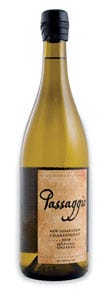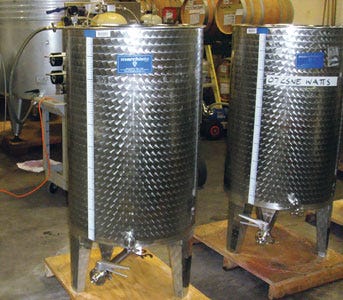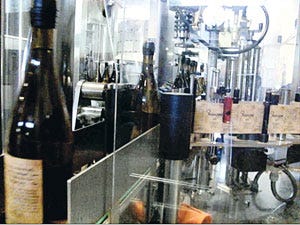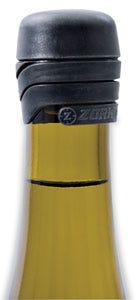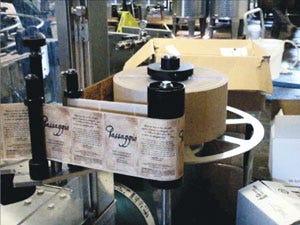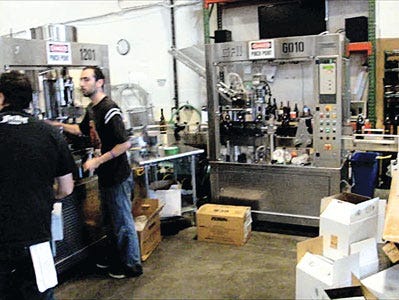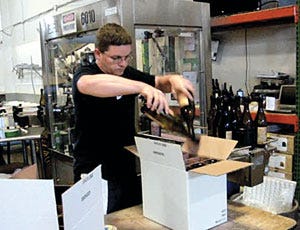Bottle-your-own wine facility lets consumers make packaging choices 2833
January 29, 2014
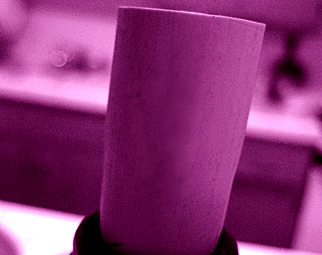
|
Since Cynthia Cosco's move to the San Francisco Bay Area in 2004, she has monitored the chemistry of thousands of barrels of wine. In just one day, Cosco has been known to analyze as many as 35 bottling tanks for customers of Crushpad, a 50,000-sq-ft do-it-yourself winemaking and bottling facility in San Francisco. These tests can be very detailed, as they include measurement of brix, total acid, pH, total and free sulfur dioxide, malolactic, alcohol, carbon dioxide, ammonia, enzymatic residual sugar and malate, volatile acidity, specific gravity and oxygen. As lab manager for Crushpad, Cosco has helped the company's more than 2,000 customers realize their winemaking dreams.
|
Stainless-steel tanks prevent malolactic fermentation in the wine, giving the chardonnay a European profile. |
A do-it-yourself tradition
For Cosco, a fourth-generation Italian American, winemaking is a part of her Italian heritage. She grew up watching her grandfather make wine in his basement. When she decided to honor this heritage by creating a wine line with a more “Italian profile” than the typical California chardonnay in 2007, Cosco needn't turn far for help in realizing this ambition.
With facilities in Bordeaux, France, and San Francisco, Crushpad offers a winemaking experience from planning the wines and selecting the vineyards from which the grapes will come, to processing the grapes and aging and packaging the wine.
In the planning stage, Crushpad works with a customer to define the style of wine he or she wants to create. Appropriate vineyard sources are determined and a winemaking plan with more than 30 detailed specifications, such as barrel type and fermentation technique, is drafted.
|
Wine is dispensed into glass bottles by a monobloc filler. |
Crushpad will monitor the growing of the grapes and report vineyard happenings. It updates customers through its Crushnet website and posts periodic vineyard videos to further update customers.
Clients are contacted when the grapes are ready for harvest. They then are invited to visit Crushpad for the grapes' arrival, upon which, they can participate in the sorting, destemming, crushing, fermenting and pressing of the grapes.
After processing, the wine is placed in barrels or tanks for a fermentation period from eight to 24 months. For optimal quality, Crushpad maintains a temperature- and humidity-controlled barrel room, a cold room, and an in-house lab for wine analysis.
To obtain an Italian profile for her Passaggio New Generation Chardonnay, Cosco chose to ferment the grapes, which were harvested in October 2007, in stainless-steel tanks instead of the oak barrels typically used for California chardonnays. The cold fermentation in stainless steel prevents the malolactic fermentation that imparts the characteristic buttery taste of a California chardonnay.
The resulting palate is clean, crisp and fruit-forward, with peaches, apricots and soft melon with a touch of lemon zest, and a firm acidity with balanced weight and a long finish.
|
Wine closures are hand-placed but are pressed onto glass bottles by a combination labeler and capsuler machine. After the caps are secured, the bottles travel to a labeling area. Roll-fed labels are then applied. |
Knowledge sharing
According to the bottler, most people find packaging decisions more difficult to make than winemaking decisions. To help with the packaging decisions, Cosco had access to Crushpad's consulting team and executives.
Packaging is one area where Cosco wanted to depart from tradition. Understanding many consumers' preference for glass, she thought it was best to stick with a traditional glass bottle so the progressive packaging would have to involve a different packaging element. Cosco decided that the “new-generation” touch to her packaging would come from a novel wine closure.
|
Her co-worker Michael Zitzlaff, who serves as Crushpad's general manager and chief winemaker, suggested the Zork closure, which was developed in Adelaide, Australia. (Zitzlaff is a graduate of Roseworthy Agricultural College in Adelaide, now the Roseworthy Campus of the University of Adelaide.) “When I was introduced to the Zork, I just fell in love with it for several reasons,” Cosco recalls. “It's cheaper than a cork, and it stands out as something different and marketable.”
Perceptions matter
Because the Zork closure doesn't require a specially made bottle, it would easily snap onto the traditional cork-mouth wine bottles that Cosco wanted to use.
Made from food-grade polymers in a plant in Tolleson, AZ, by Portola Packaging Inc., the three-part closure is engineered to provide a consistent barrier with an oxygen transmission rate of less than 0.0078 cc/day and not taint as corks can. According to consumer research published by Zork USA on its website, wines sealed with Zork closures can taste fresher and more rounded than those sealed with screw caps.
The closure provides tamper-evidence, with a clamp that locks onto the European Centre Technique International de l'Embouteillage band of a standard cork-mouth bottle; its inner metal foil provides an oxygen barrier; and an inner plunger allows consumers to reseal the bottle.
|
To accommodate short bottling runs, Crushpad offers digitally printed labels. These roll-fed labels, were printed on a digital offset press using liquid toner. |
|
The packaging line is set up to allow clients to participate in nearly all aspects of the bottling process. |
|
Filled bottles are packed for distribution throughout the Bay Area. |
It also addresses consumer perception considerations for wine. Upon extraction, the Zork closure provides audible feedback similar to that of a cork. To provide a premium appearance, the closure is available in red, black and burgundy from stock and other standard and custom colors upon request. Standard colors include gold; yellow, silver; dark green; and navy.
The ability to print on the top of the Zork helps eliminate the need for overwrap for presentation. Two spot colors plus white can be used for printing the 24-mm circular image area with a 2-mm void center concentric to the closure's top.
Easy to work with
Crushpad uses one packaging line to bottle all wines at its San Francisco facility. “It's a singular line because we do small lots at a time,” Cosco explains. “Most customers are getting 25 cases, which is one barrel lot.”
The stainless steel tanks from which New Generation Chardonnay is pumped were supplied by Oak Barrel Winecraft. The tanks are made by F.lli Marchisio & C. S.p.A in Italy from food-grade stainless steel, which doesn't react chemically to wine. A filler from GAI S.r.L. dispenses wine into the glass bottles, which are supplied by Trilogy Glass & Packaging.
The filler uses a patented design that shuts off the flow of wine and the gas backflow. This benefits both oxidation and sterility as the filler tank is in contact only with the atmosphere created in the bottle.
The labeler and capsuler also is a machine built by GAI. Each bottle has a hand-placed Zork closure on top. After the cap is placed on the bottle, the capsuler lifts the bottle up to press the Zork closure on.
The bottles travel to one side of the machine to be labeled. The labels are process-printed by Tapp on a Hewlett-Packard Indigo press at the converter's plant in Napa.
Filled, capped and labeled bottles are hand-packed in cases. Cosco distributes to her wines directly to consumers through her company's web site—www.passaggiowines.com. The unoaked chardonnay also can be found at Ferry Plaza Wine Merchant in San Francisco; Oxbow Wine Merchants in Napa, CA; the Valley Wine Shack in Sonoma,CA; and Italian restaurants and cafes including The Corner, a Italian eatery in San Francisco with a coffee-and-wine bar.
More to come
Thus far, response from the 2007 and 2008 varietals has been good. “Waiters, sommeliers and other restaurant people like my wine because they don't have to use a cork puller,” Cosco remarks. “Consumers like it because the packaging is different.”
While the wine is a personal tribute to a family tradition, Cosco is quick to share the credit for her success with Crushpad wine chemist Justin Rose, bottling-line manager Pete Mcafee, bottling and packaging manager Jeremy Weiss, senior (label) designer Hayley Partridge and, of course, Zitzlaff.
The entrepreneur plans to launch two more varietals at the end of the upcoming harvest.
More information is available: |
Zork USA, 866/996-9675. www.zorkusa.com |
Portola Packaging Inc., 800/767-8652. www.portpack.com |
Crushpad Inc., 877/946-3404. www.crushpadwine.com |
GAI S.r.L., 39-01-72-57-4416. www.gai-it.com |
F.lli MARCHISIO & C. S.p.A, 39-0-18-33-6237. www.fratellimarchisio.com |
Hewlett-Packard Development Co. L.P., 800/752-0900. www.hp.com |
Oak Barrel Winecraft, 510/849-0400. www.oakbarrel.com |
Tapp, 888/834-8277. www.tapptech.com |
Trilogy Glass & Packaging, 707/566-9000. www.trilogyglass.net |
About the Author(s)
You May Also Like
